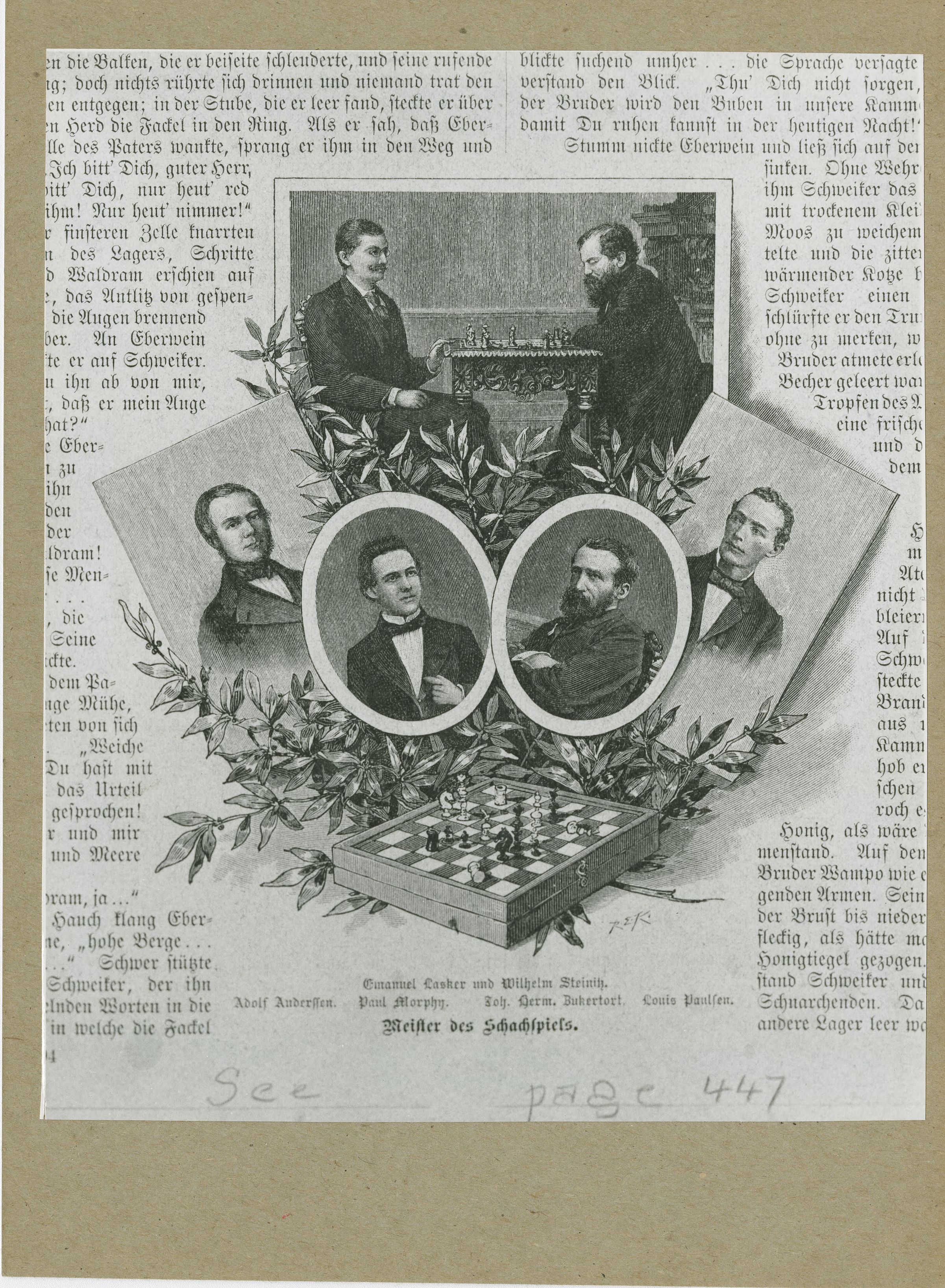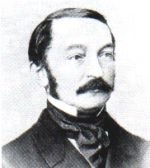|
Adolf Anderssen
Karl Ernst Adolf Anderssen (July 6, 1818 – March 13, 1879)"Anderssen, Adolf" in ''The New Encyclopædia Britannica''. Chicago: Encyclopædia Britannica Inc., 15th edn., 1992, Vol. 1, p. 385. was a German chess master. He won the great international tournaments of 1851 and 1862, but lost matches to Paul Morphy in 1858, and to Wilhelm Steinitz in 1866. Accordingly, he is generally regarded as having been the world's leading chess player from 1851 to 1858, and leading active player from 1862 to 1866, although the title of World Chess Champion did not yet exist. Anderssen became the most successful tournament player in Europe, winning over half the events he entered, including the very strong Baden-Baden 1870 chess tournament. He achieved most of these successes when he was over the age of 50. Anderssen is famous today for his brilliant sacrificial attacking play, particularly in the "Immortal Game" (1851) and the "Evergreen Game" (1852). He was an important figure in the devel ... [...More Info...] [...Related Items...] OR: [Wikipedia] [Google] [Baidu] |
Wrocław
Wrocław (; german: Breslau, or . ; Silesian German: ''Brassel'') is a city in southwestern Poland and the largest city in the historical region of Silesia. It lies on the banks of the River Oder in the Silesian Lowlands of Central Europe, roughly from the Baltic Sea to the north and from the Sudeten Mountains to the south. , the official population of Wrocław is 672,929, with a total of 1.25 million residing in the metropolitan area, making it the third largest city in Poland. Wrocław is the historical capital of Silesia and Lower Silesia. Today, it is the capital of the Lower Silesian Voivodeship. The history of the city dates back over a thousand years; at various times, it has been part of the Kingdom of Poland, the Kingdom of Bohemia, the Kingdom of Hungary, the Habsburg monarchy of Austria, the Kingdom of Prussia and Germany. Wrocław became part of Poland again in 1945 as part of the Recovered Territories, the result of extensive border changes and expulsions ... [...More Info...] [...Related Items...] OR: [Wikipedia] [Google] [Baidu] |
Daniel Harrwitz
Daniel Harrwitz (22 February 1821 – 2 January 1884) was a German chess master. Harrwitz was born in Breslau (Wrocław) in the Prussian Province of Silesia. Harrwitz's correct birth and death dates (22 February 1821 and 2 January 1884 respectively) were established by Luca D'Ambrosio in Chess Notes item 6286. He established his reputation in Paris, particularly as a player of blindfold games. He lost a match in England to Howard Staunton in 1846 at odds of a pawn and two moves, and drew a match with Adolf Anderssen in Germany in 1848. Harrwitz lived in England from 1849, and founded the ''British Chess Review''. In 1856 he moved to Paris, where he won a match against Jules Arnous de Rivière. In 1858 he played a match against Paul Morphy in Paris. Harrwitz won the first two games, but lost the match 5½-2½. Harrwitz withdrew from the match, allegedly on grounds of ill health. He subsequently retired to the Austro-Hungarian county of Tyrol, dying in Bolzano in 1884. Game agains ... [...More Info...] [...Related Items...] OR: [Wikipedia] [Google] [Baidu] |
Ludwig Bledow
Dr Ludwig Erdmann Bledow (27 July 1795, Berlin – 6 August 1846, Berlin) was a German chess master and chess organizer (co-founder of the Berlin Pleiades). In 1846 he founded the first German chess magazine, ''Schachzeitung der Berliner Schachgesellschaft'', which would later take the name ''Deutsche Schachzeitung''. Influence on the game Several details of the game's moves and competition rules had not yet been universally agreed in Bledow's time, and some were still being debated in 1851.. Can be viewed online or downloaded at Bledow, influenced by Karl Schorn, agreed that a player should be allowed to have multiple queens (as a result of pawn promotions), so that chess rules in Germany fell in line with the French and English way of playing. He also argued strongly in favour of the touch-move rule. Bledow wrote a letter to Tassilo von Heydebrand und der Lasa (usually abbreviated as "von der Lasa") proposing that an international tournament should be organized in Trier; the let ... [...More Info...] [...Related Items...] OR: [Wikipedia] [Google] [Baidu] |
Deutsche Schachzeitung
''Deutsche Schachzeitung'' (English: "''German Chess Paper''") was the first German chess magazine. Founded in 1846 by Ludwig Bledow under the title ''Schachzeitung der Berliner Schachgesellschaft'' and appearing monthly, it took the name ''Deutsche Schachzeitung'' in 1872. (Another magazine used the title ''Deutsche Schachzeitung'' from 1846 to 1848.) When it ceased publication in December 1988 it was the oldest existing magazine in the world, having been published regularly since its founding in 1846 except for a five-year break (1945–1949) following World War II. Since January 1989, the ''Deutsche Schachzeitung'' was merged in the ''Deutsche Schachblätter – Schach-Report'' which was edited in Hollfeld Hollfeld is a town in the district of Bayreuth, in Bavaria, Germany. It is situated 20 km west of Bayreuth, and 30 km east of Bamberg. Sport The towns association football club, ASV Hollfeld, experienced its greatest success in 2012 .... The resulting magazine ... [...More Info...] [...Related Items...] OR: [Wikipedia] [Google] [Baidu] |
Tassilo Von Heydebrand Und Der Lasa
Tassilo, Baron von Heydebrand und der Lasa (known in English as Baron von der Lasa, 17 October 1818, Berlin – 27 July 1899, Storchnest near Lissa, Greater Poland, then German Empire) was a German chess master, chess historian and theoretician of the nineteenth century, a member of the Berlin Chess Club and a founder of the Berlin Chess School (the Berlin Pleiades). His name is usually abbreviated as "von der Lasa", as this is how he signed his letters. However both contemporary and more recent writers have used other abbreviations, such as "von Heydebrandt" (which is a misspelling) and "Der Lasa". The Prussian King (later Emperor) William I made a joke out of the confusion by saying, "Good morning, dear Heydebrand. What is von der Lasa doing?" Von der Lasa was born 17 October 1818 in Berlin. He studied law in Bonn and Berlin. From 1845 he was a diplomat in the service of Prussia. His career took him to Stockholm, Copenhagen, and Rio de Janeiro, among other places. He ... [...More Info...] [...Related Items...] OR: [Wikipedia] [Google] [Baidu] |
Berlin Pleiades
The Berlin Pleiades was a group of seven masters of German chess in the 19th century. They are named after the star constellation the Pleiades. The members of the Berlin Pleiades were: * Paul Rudolf von Bilguer, Army Lieutenant and author of the ''Handbuch des Schachspiels'', the most influential chess book for 90 years; * Dr. Ludwig Bledow, teacher of mathematics and the Pleiades co-founder; * Wilhelm Hanstein, civil servant; * Bernhard Horwitz, painter; * Baron Tassilo von Heydebrand und der Lasa, later became a Prussian diplomat and chess historian; * Carl Mayet Carl (Karl) Mayet (11 August 1810, Berlin – 18 May 1868, Stettin, now Szczecin) was a German chess master. He was one of the most original of the Berlin Pleiades (the seven stars of German chess). In 1839, Mayet defeated Jozsef Szen in a match ..., barrister and judge; * Carl Schorn, painter. File:Bilguer.jpg, Paul von Bilguer File:Bledow.jpg, Ludwig Bledow File:WilhelmHanstein.jpg, Wilhelm Hanstein File:Bernhar ... [...More Info...] [...Related Items...] OR: [Wikipedia] [Google] [Baidu] |
Chess Problems
A chess problem, also called a chess composition, is a puzzle set by the composer using chess pieces on a chess board, which presents the solver with a particular task. For instance, a position may be given with the instruction that White is to move first, and checkmate Black in two moves against any possible defence. A chess problem fundamentally differs from over-the-board play in that the latter involves a struggle between black and white, whereas the former involves a competition between the composer and the solver. Most positions which occur in a chess problem are 'unrealistic' in the sense that they are very unlikely to occur in over-the-board play. There is a good deal of specialized jargon used in connection with chess problems; see glossary of chess problems for a list. Definition The term "chess problem" is not sharply defined: there is no clear demarcation between chess compositions on the one hand and puzzles or tactical exercises on the other. In practice, however, t ... [...More Info...] [...Related Items...] OR: [Wikipedia] [Google] [Baidu] |
Alexander McDonnell (chess Player)
Alexander McDonnell (1798–1835), sometimes spelled MacDonnell, was an Irish chess master, who contested a series of six matches with the world's leading chess player Louis-Charles Mahé de La Bourdonnais in 1834. Early life The son of a surgeon, Alexander McDonnell was born in Belfast in 1798. He was trained as a merchant and worked for some time in the West Indies. In 1820 he settled in London, where he became the secretary of the Committee of West Indian Merchants in which role he advocated strongly on behalf of slave-owning sugar plantation owners. It was a lucrative post that made him a wealthy man and left him with plenty of time to indulge his passion for chess. In his politics McDonnell was a committed Whig. Chess career In 1825 he became a pupil of William Lewis, who was then the leading player in Britain. But soon McDonnell had become so good that Lewis, fearing for his reputation, simply refused to play him anymore. Around 1825–1826, McDonnell played Capt ... [...More Info...] [...Related Items...] OR: [Wikipedia] [Google] [Baidu] |
Louis-Charles Mahé De La Bourdonnais
Louis-Charles Mahé de La Bourdonnais (1795 – December 1840) was a French chess master, possibly the strongest player in the early 19th century. Early life La Bourdonnais was born on the island of Réunion in the Indian Ocean in 1795. He was the grandson of Bertrand-François Mahé de La Bourdonnais. He learned chess in 1814 and began to take the game seriously in 1818, regularly playing at the Café de la Régence. He took lessons from Jacques François Mouret, his first teacher, and within two years he became one of the best players of the ''Café''. Chess career La Bourdonnais was forced to earn his living as a professional chess player after squandering his fortune on ill-advised land deals. He played in an era before a World Chess Championship was established, but was considered to be perhaps the strongest player in the world from 1821 — when he became able to beat his chess teacher Alexandre Deschapelles — until his death in 1840. The most famous match series in ... [...More Info...] [...Related Items...] OR: [Wikipedia] [Google] [Baidu] |
William Lewis (chess Player)
William Lewis (1787–1870) was an English chess player and author, nowadays best known for the Lewis Countergambit. He may have been the first player ever described as a Grandmaster of the game. Life and works Born in Birmingham, William Lewis moved as a young man to London where he worked for a merchant for a short period. He became a student of chess player Jacob Sarratt, but in later years he showed himself to be rather ungrateful towards his teacher. Although he considered Sarratt's ''Treatise on the Game of Chess'' (1808) a "poorly written book", in 1822 Lewis published a second edition of it three years after Sarratt's death in direct competition with Sarratt's own superior revision published posthumously in 1821 by Sarratt's poverty-stricken widow. In 1843, many players contributed to a fund to help the old widow, but Lewis' name is not on the list of subscribers. Around 1819 Lewis was the hidden player inside the Turk (a famous automaton), meeting all-comers success ... [...More Info...] [...Related Items...] OR: [Wikipedia] [Google] [Baidu] |



.png)